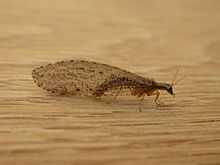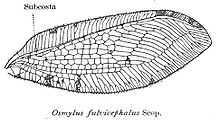Osmylidae
| Osmylidae | |
|---|---|
 | |
| Stenosmylus sp. | |
| Scientific classification | |
| Kingdom: | Animalia |
| Phylum: | Arthropoda |
| Class: | Insecta |
| Order: | Neuroptera |
| Suborder: | Hemerobiiformia |
| Superfamily: | Osmyloidea |
| Family: | Osmylidae |
| Subfamilies | |
|
Eidoporisminae | |

Osmylidae are a small family of winged insects of the net-winged insect order Neuroptera. The osmylids are found all over the world except in North America. A common species through most of Europe is Osmylus fulvicephalus.
Description and ecology

Adult osmylids are small to moderately-sized net-winged insects, with wingspans ranging from 1.4 to 3 cm. Smaller members resemble typical green lacewings, and larger species resemble antlions. Many species, namely those of the type genus Osmylus, have spotted wings. The thin antennae are short. They have two compound eyes, as well as three ocelli in between. Adult osmylids, like green lacewings (colloquially known as "stinkflies"), have prothoracal glands which produce foul-smelling compounds used to deter would-be predators.
Their larvae are superficially similar to those of spongillaflies (Sisyridae). They have peculiar mouthparts which look like a thin forceps with the ends bending outwards. The body is elongated and slender and terminates in two extensible graspers bearing tiny hooks; these are used to aid in locomotion and to grasp prey. The adults are diurnal or crepuscular weak-flying insects which mostly prey on small invertebrates, supplemented with some pollen. Eggs are deposited in damp places, usually near freshwater. The larvae are associated with damp, mossy habitats and are amphibious. They hunt small invertebrate prey, from which they suck the body fluids with their mouthparts.

Systematics and taxonomy
The Sisyridae (spongillaflies) were formerly believed to be closely related. But as it seems they are well distinct, the presumed close relationship being mistaken due to their larvae's superficial similarity caused by convergent evolution. Rather, the green lacewings (Chrysopidae) appear to be the osmylids' closest living relatives; together with some prehistoric lineages the Chrysopidae form superfamily Chrysopoidea which is sister to the presently monotypic Osmyloidea.
The two subfamilies Eidoporisminae and Porisminae each contain only a single species, Eidoporismus pulchellus and Porismus strigatus, respectively. Both are endemic to Australia. A quite basal fossil member not assignable to a subfamily, Protosmylus, has been found encased in amber.[1]
Footnotes
- ↑ Engel & Grimaldi (2007)
References
| Wikimedia Commons has media related to Osmylidae. |
- This article draws heavily on the corresponding article in the German-language Wikipedia.
- Engel, Michael S. & Grimaldi, David A. (2007): The neuropterid fauna of Dominican and Mexican amber (Neuropterida, Megaloptera, Neuroptera). American Museum Novitates 3587: 1-58. PDF fulltext
- Haaramo, Mikko (2008): Mikko's Phylogeny Archive: Neuroptera. Version of 2008-MAR-11. Retrieved 2008-APR-27.
| ||||||||||||||||||||||||||||||||||||||||||||||||||||||||||||||||||||||||||||||||||||||||||||||||||||||||||||||||||||||||
| ||||||||||||||||||||||||||||||||||||||||||||||||||||||||||||||||
